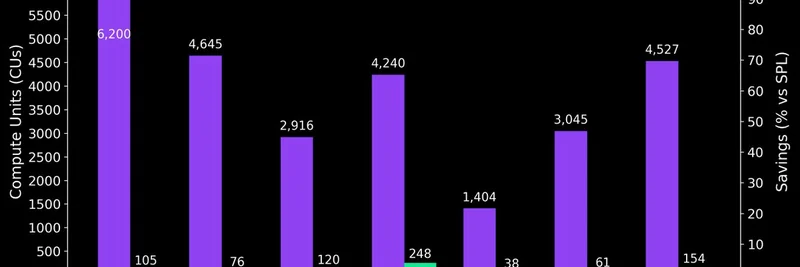Anza, a key player in Solana's development ecosystem, just dropped a game-changing proposal that's got the crypto community buzzing. In a recent thread on X, they introduced SIMD-0266, an efficient token program dubbed "p-token." This isn't just another update—it's a potential overhaul that could slash compute unit (CU) consumption for token operations by up to 98%. For meme token enthusiasts and blockchain builders, this means cheaper, faster transactions on Solana, potentially supercharging the meme coin scene.
Let's break it down. Right now, about 10% of Solana's block compute units are chewed up by the current SPL token program—the standard for handling tokens on the network. Things like transferring tokens, initializing accounts, or closing them all rack up these CUs, which are essentially the "gas" measuring computational effort in Solana transactions. High CU usage can lead to higher fees and congested blocks, especially during meme coin frenzies when trading volume spikes.
Enter p-token, a complete reimplementation of the SPL token program. Authored by @0x_febo and proposed by Anza, it's designed from the ground up for efficiency. No heap allocations (which means less memory overhead), zero-copy data access (faster processing without duplicating data), and full backward compatibility. That last part is crucial—if you're building or trading meme tokens, you won't need to rewrite any code. It's a plug-and-play replacement that keeps everything running smoothly while optimizing under the hood.
The chart from Anza's thread highlights the savings across common instructions. For instance, TransferChecked drops from over 6,000 CUs in SPL to just 105 in p-token—a whopping 98% reduction. Other ops like InitializeAccount3 see CU costs plummet from 4,240 to 248. Overall, this could free up nearly 12% of block space, allowing more transactions per block and boosting Solana's throughput. Imagine launching a new meme token during a hype cycle without worrying as much about network jams or skyrocketing fees.
But p-token doesn't stop at cost cuts. It introduces new instructions like Batch and UnwrapLamports, tailored for DeFi patterns that often involve multiple token operations. Batch lets you bundle several actions into one cross-program invocation (CPI), reducing overhead. UnwrapLamports eliminates the need for temporary native accounts, streamlining processes further. For meme token projects, this could mean more complex smart contracts—like automated liquidity pools or reward distributions—running more affordably.
This upgrade aligns with broader Solana improvements, such as aiming for 100 million CU blocks and higher per-account limits. An independent audit by Neodyme replayed real mainnet transactions and confirmed p-token produces identical results to the current SPL program, ensuring reliability.
For the meme token community, the implications are huge. Solana has become a hotspot for viral coins thanks to its speed and low costs, but scalability tweaks like this could attract even more creators and traders. Lower CU usage means more room for pump.fun launches, DEX trades, and community-driven events without breaking the bank.
If you're diving into Solana meme tokens, keep an eye on this. The full proposal is up for discussion on GitHub—check it out here and join the conversation. As Solana evolves, updates like p-token could make it the go-to chain for the next wave of meme mania. What's your take? Will this ignite a new era for Solana memes?



